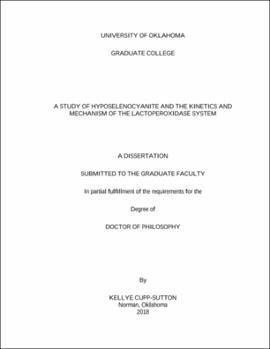| dc.description.abstract | The lactoperoxidase system, defined as lactoperoxidase in the presence of hydrogen peroxide and thiocyanate, is a powerful method of host defense, particularly in mammalian secretory mucosae. The product of this system, hypothiocyanite, functions as an antimicrobial by oxidizing bacterial sulfhydryls, thereby inhibiting bacterial respiration. The lactoperoxidase system and its product, hypothiocyanite, have been the focus of study for over a century. We explore herein the function of selenocyanate as a substrate of the lactoperoxidase system and we reinterpret the mechanism of the lactoperoxidase system with is natural substrate, thiocyanate.
There is new evidence in the literature that selenocyanate, the selenium derivative of thiocyanate, is present in mammals and concentrated in the secretory mucosae using the same active membrane transport mechanism as thiocyanate. However, the ability of lactoperoxidase to utilize selenocyanate as a substrate for the lactoperoxidase system has never been studied. Furthermore, the selenium derivative of hypothiocyanite, hyposelenocyanite, has not been previously characterized.
We successfully synthesized hyposelenocyanite via the oxidation of selenocyanate by hypochlorous acid at alkaline pH and using the lactoperoxidase system. Hyposelenocyanite produced at alkaline pH was characterized spectrophotometrically by comparison with the known spectrum of hypothiocyanite. The rate of oxidation of selenocyanate by hypochlorous acid at alkaline pH is faster than the oxidation of thiocyanate by hypochlorous acid by two orders of magnitude which is expected given the higher reactivity of selenium analogs of sulfur compounds. Similarly, the decomposition of hyposelenocyanite at alkaline pH is several orders of magnitude faster than the hydrolysis of hypothiocyanite under the same conditions.
The lactoperoxidase system was also used to synthesize hyposelenocyanite, which was observed spectrophotometrically via the reaction of hyposelenocyanite with 5-thio-2-nitrobenzoic acid. Remarkably, while observing the ability of the lactoperoxidase system to catalyze selenocyanate oxidation, we observed unexpected kinetics that could not be explained by the accepted mechanism of catalysis.
The reported literature mechanism of lactoperoxidase catalysis of halide and pseudohalide oxidation by hydrogen peroxide is known as the halogen cycle. The halogen cycle is reported in the literature as an ordered sequential mechanism where lactoperoxidase is oxidized in a two-electron oxidation reaction by hydrogen peroxide to produce compound I. Compound I then reacts with a halide or pseudo-halide to produce native lactoperoxidase and the hypo(pseudo)halous acid. When the reaction of compound I with hydrogen peroxide is rate-limiting, as has been reported for thiocyanate, the kinetics of the halogen cycle reaction are expected to be first-order in hydrogen peroxide and independent of reducing substrate concentration.
We performed a series of stopped-flow UV-Vis experiments with varying concentrations of reactants and enzyme and found that at high concentration of reducing substrate (relative to the concentration of hydrogen peroxide) the kinetics observed for the lactoperoxidase-catalyzed oxidation of thiocyanate and selenocyanate reflect what is expected according to the halogen cycle literature mechanism (although we reinterpret the kinetics in terms of a new mechanism). However, at low concentration of reducing substrate (relative to hydrogen peroxide) the reaction becomes biphasic, a first-order reaction followed by a zeroth-order reaction.
We propose a new mechanism which accounts for the kinetics that are observed under all reaction conditions. The proposed mechanism is an ordered sequential mechanism where the initial reaction is the binding of lactoperoxidase with the reducing substrate. This bound lactoperoxidase species then reacts with hydrogen peroxide to produce native lactoperoxidase and the hypo(pseudo)halite. However, hydrogen peroxide, in addition to acting as the oxidizing substrate, also acts as a tight binding inhibitor of lactoperoxidase to produce a lactoperoxidase-hydrogen peroxide bound species which is inactive or less active in catalysis. Experimental data were fit to the proposed model for the lactoperoxidase-catalyzed oxidation of thiocyanate and selenocyanate to elucidate absolute rate constants for the mechanism.
The biological significance of the kinetics we observe when the concentration of hydrogen peroxide exceeds the concentration of the thiocyanate substrate, when hydrogen peroxide inhibition of lactoperoxidase is observed, depends on the reaction conditions in vivo. Concentration conditions that promote hydrogen peroxide inhibition of lactoperoxidase are not expected to be prevalent in healthy humans. However, it is conceivable that certain disease conditions promote the higher hydrogen peroxide concentrations and lower thiocyanate concentrations required for lactoperoxidase inhibition by hydrogen peroxide. Using the oral cavity as an example, inflammation of the gingival crevasse promotes phagocytosis that results in the extracellular production of hydrogen peroxide. Inflammation of gingival tissue also promotes the excretion of gingival crevicular fluid, which naturally lowers the concentration of thiocyanate. Since many oral pathogenic bacteria are obligate anaerobes, it may be advantageous to deactivate the defensive peroxidases to raise the local concentration of hydrogen peroxide for the purpose of staving off infection. A better argument for such a defensive mechanism could be made if the other principal defensive peroxidase of the oral cavity, myeloperoxidase, is inhibited by hydrogen peroxide via a similar mechanism. Accordingly, additional mechanistic studies of the other defensive peroxidases are warranted. | en_US |
